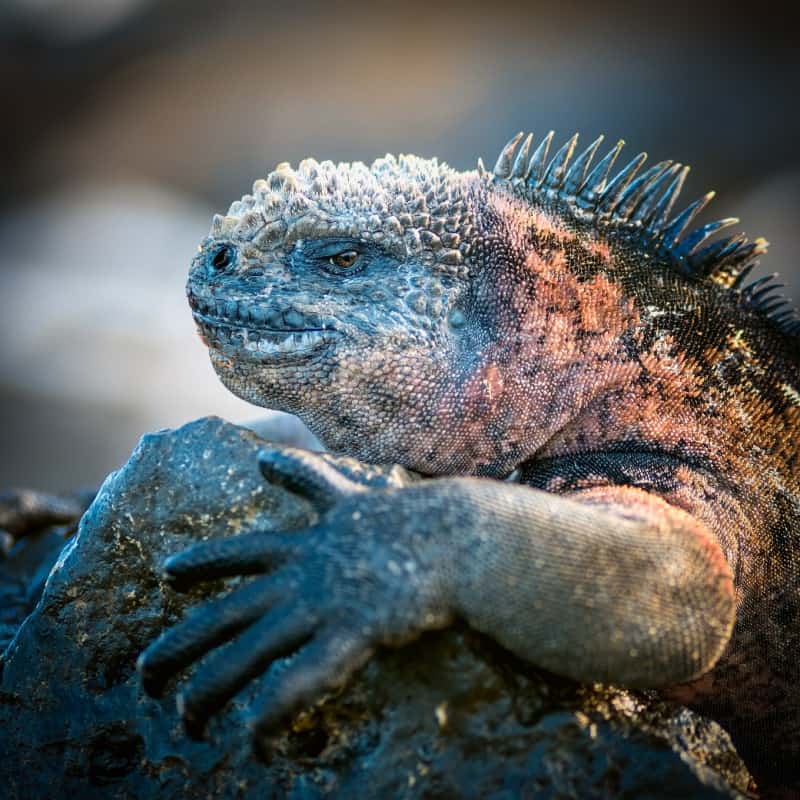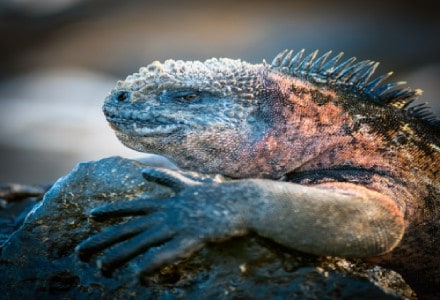
Marine Iguana Facts
- The descriptive term of Marine Iguana serves as the most frequently used common name for this true marvel of evolution. It does go by other unofficial titles, though. These include the terms sea iguana, saltwater iguana, and Galapagos marine iguana.
- Among scientific professionals, however, it’s more typically referred to by its formal name. That, though, is a hard to pronounce term for the layman. That’s because it bears the tongue-twisting technical moniker of the Amblyrhynchus cristatus.
- The animal received that difficult name due to the efforts of the respected English zoologist, Thomas Bell. He recorded the first official recognition of the reptile as a separate and distinct species. He accomplished this noteworthy evernt in 1825.
- Regardless of which term one chooses to use when speaking of it, the animal remains exceptional. This holds true due to a unique quirk of evolution. To our current knowledge, it’s the only lizard in the world able to live and forage in the ocean.
- Sadly, the amazing Marine Iguana has a relatively small population base. It also inhabits an extremely limited range. The IUCN therefore presently lists the intriguing product of Nature as Vulnerable on its published Red List of Threatened Species.
- Due to its precise situation, the animal understandably faces multiple threats to its continued existence. Its own limited range, as well as the presence of introduced predators place it in peril. Its greatest threat, however, likely consists of climate change.
Related Articles
American Crocodile Tuatara Komodo Dragon
Marine Iguana Physical Description
The fabulous Marine Iguana evolved a form that almost instantly amazes those who encounter the animal. Unlike some reptiles, however, it does so due to a combination of several factors. These include overall general appearance, as well as sheer physical size.
The impressive creature does follow one pattern common to most reptiles, though. That’s in the fact that it displays a marked degree of the physiological trait of sexual dimorphism. In the case of this particular reptile, that trait manfests itself in terms of length and weight.
Males of the species attain a maximum known length of roughly 4.3 ft (1.3 m). Interestingly, this varies significantly between populations in different parts of its range. The same holds true for its weight. For the males, though, this reaches approximately 26 lb (11.8 kg).
Their female counterparts attain much smaller measurements, though. In terms of length, this equals an average of only 2.0 ft (0.6 m). A maximum weight for females is only about half that of the males. But, most specimens of both genders average less in both categories.
Otherwise, males and females remain virtually indistinguishable to the untrained eye, except for one thing. Adult males of this animal vary in color with the seasons. That’s because their color patterns brighten during breeding season, to attract potential mates.
Outside of that seasonal deviation by the males, the Marine Iguana presents a fairly uniform outward appearance in coloring. This consists of various shades of gray or black across the body. That body also develops as relatively thickset, with sturdy, powerful limbs.
- Kingdom: Animalia
- Phylum: Chordata
- Class: Reptilia
- Order: Squamata
- Family: Varanidae
- Genus: Varanus
- Species: V. komodoensis
Marine Iguana Distribution, Habitat, and Ecology
Regrettably, the extraordinary Marine Iguana evolved as native to an extremely small zone of habitation. It’s unknown if the animal ever appeared beyond its present range. That same region also holds an abundance of other natural wonders, both flora and fauna.
That’s all true given the fact that the well-adapted reptile dwells only on the beautiful Galapagos Islands. These also qualify as a marvel of Nature. While not physically connected, of course, these sites form part of the country of Ecuador, in South America.
In terms of habitat, this animal completely distinguishes itself from every other known reptile on the planet. That distinction holds true due to a startling fact. Unlike all its identified kin, this reptile evolved to be just as at home in the ocean as it is on the land!
The astoundingly adapted species spends a great deal of its time swimming in the surrounding ocean. There, it has the ability to remain underwater for up to 30 minutes at a time. Typically, though, individuals limit this to no more than a few minutes at a time.
The Marine Iguana evolved a diet every bit as unique as itself. The animal feeds as a herbivore. Its flattened snout allows it to scrape the various algae forming the bulk of its diet from rocks in the surrounding waters. Small insects and crustaceans complete this.
Breeding typically occurs near the end of the dry season. Males usually assemble herds of females, and aggressively guard them from other males. Individuals sometimes live as long as 60 years, but the lifespan only averages around 12 years. A clutch averages 1 – 6 eggs.
Species Sharing Its Range
Check out our other articles on 10 Extraordinary Reptiles, Great White Shark, Devetashka Cave, Visayan Spotted Deer, Nevin’s Barberry, Pellucid Hawk Moth, Tawny Frogmouth

